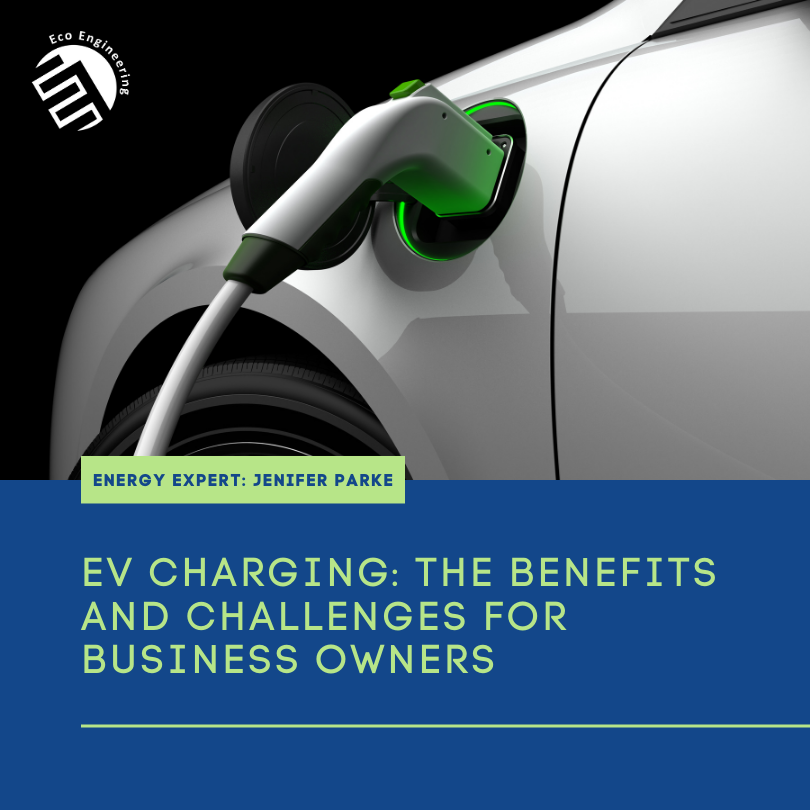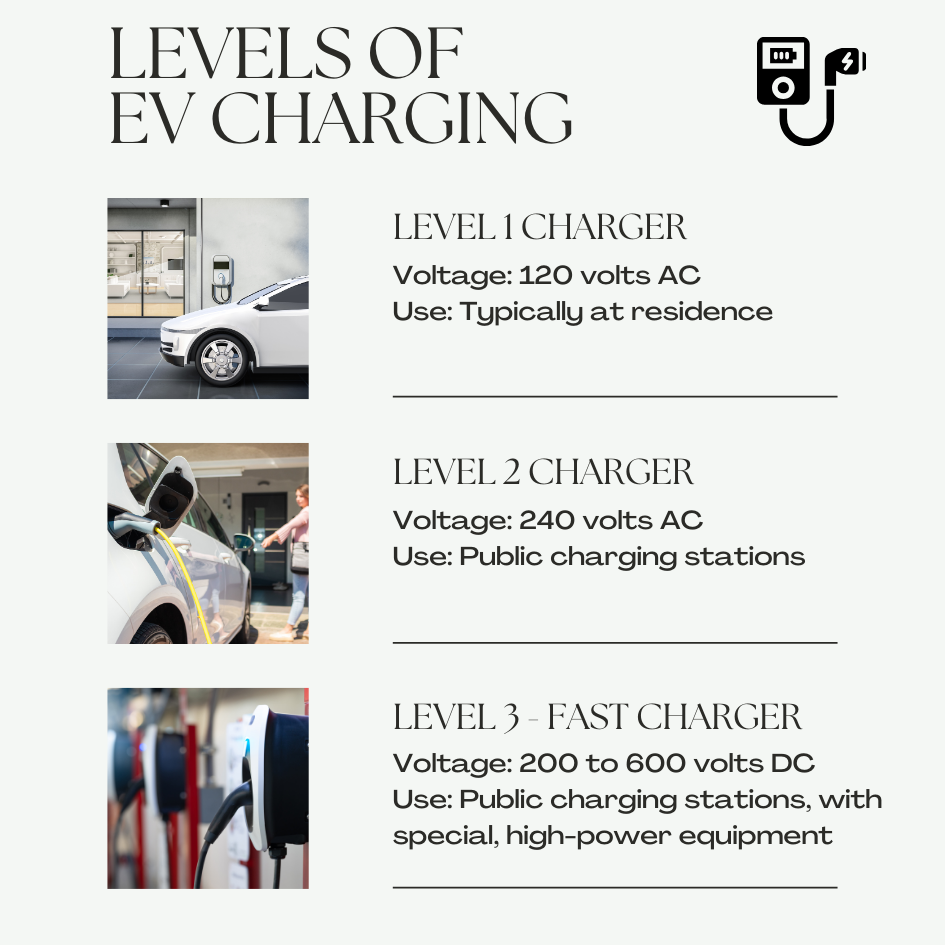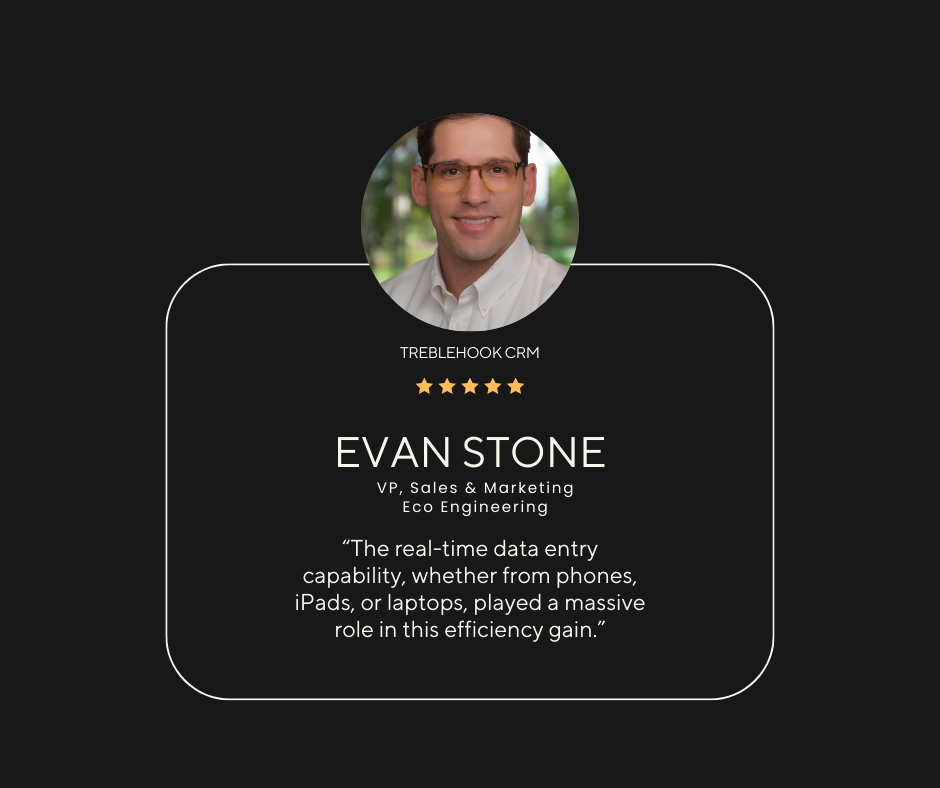We are experiencing a movement where auto dealerships, franchises, business, and property owners are making strategic moves to align with evolving consumer preferences, environmental regulations, and the broader shift toward eco-friendly practices. One of the many impactful shifts taking place is within the automotive landscape, more specifically, the surge of electric vehicles (EVs) and fleet EVs. This has prompted businesses to reevaluate their strategies with many choosing to invest in EV charging infrastructure, and if applies, take advantage of various local and federal incentives and grant programs.

We asked Jenifer Parke, Energy Expert at Eco Engineering, to highlight how business owners embracing EV charging infrastructure can benefit by attracting a broader customer base, enhancing brand image, creating additional revenue streams, and take advantage of government incentives and grants. Jen also shares challenges that business owners should be prepared for in the transition to EV charging infrastructure, and how the right partner can help owners navigate the challenges.
4 Benefits of EV Charging Infrastructure
1. Increased Foot Traffic, Customer Loyalty, and Employee Appreciation
As the demand of EVs continues to rise, so does the demand for accessible charging stations or fleet vehicle charging. By embracing EV charging infrastrusture, it can introduce new ways for brands and business owners to connect with a broader customer base and further position themselves as a leader in sustainability. In addition, to attracting more customers, it also presents the opportunity to provide an advantage to current and future employees and their need for access to EV charging.
ROI: Increased foot traffic can lead to higher sales and enhanced customer loyalty and employee appreciation.
2. Positive Public Relations
Business owners who adopt EV charging showcase their commitment to environmental responsibility and innovation. This positive association can lead to increased brand loyalty and trust among consumers, as they align themselves with businesses that prioritize a sustainable future.
ROI: News of a business’s commitment to sustainability and investment in EV charging infrastructure is picked up by local media, creating positive public relations and community goodwill.
3. Additional Revenue Stream
While the initial investment of EV charging infrastructure may seem substantial, business owners should consider the opportunity to create additional revenue stream(s) to monetize their investment. Options can include subscription models like credit card transactions per usage, advertising, pay-per-use fees, or partnerships with EV manufacturers.
ROI: A business owner partners with an EV charger manufacturer to gain revenue through credit card transactions for each use of the EV charging unit.
4. Government Incentives and Grants
By installing EV charging infrastructure, commercial businesses may qualify for tax credits, grants, or other financial benefits from local or federal government programs. These incentives aim to support the adoption of EV technology, reduce carbon emissions, and promote environmental sustainability.
ROI: In regions with supportive policies, business owners may benefit from government incentives for installing EV charging infastrucure, reducing the overall financial burden.
4 Challenges of Investing in EV Charging
1. High Initial Investment
Some business owners may not realize the upfront expenses involved in setting up EV charging infrastructure, including costs for engineering, design, materials, and labor.
Solution: Though the initial investment for EV charging infrastructure can be steep, partnering with the right organization can help business owners find federal and local programs that offer incentives or grants to significantly reduce costs. For example, Eco Engineering is assisting Ford Motor Company’s Blue Oval Charging Network, a recent initiative aiming to install over 84,000 EV chargers across North American dealerships. Through collaborations with local Ford dealerships in Pennsylvania, Eco Engineering is helping to cut project expenses using local grants and incentives.
2. Controlling Utility Rates
It can be common for a utility to raise the average rate for usage after EV charger infastructure have been installed creating an unexpected cost increase, impacting the ROI. An electricity bill could average around $200 per month, and unexpectedly increase to $500 without the proper contracts in place.
Solution: This can often be an oversight in the project cost and ROI, but Eco Engineering can help business owners negotiate with the utility to ensure more predictable and affordable pricing.
3. Technological Evolution
Rapid advancements in EV technology may result in charging infrastructure becoming outdated sooner than expected, necessitating ongoing investments to stay current.
Solution: Manufacturers such as ChargePoint, Blink, and EVMax powered by Lyncwell have dedicated expert resources to ensure ongoing maintenance support is available to their customers.

4. Understanding Which EV Charging Station Levels Business Owners Need
Determining the EV charger infastructure and level you need to install onsite can come with challenges such as anticipating what consumers will require at your business. There are multiple factors to consider in your selection such as infrastructure, compatibility, safety, and cost. Here are the three primary EV charger levels to consider installing:
- Level 1 Charging:
- Voltage: 120 volts AC
- Power Output: Typically, around 1.4 to 1.9 kilowatts (kW)
- Charging Speed: Slow
- Usage: Employing a standard household electrical outlet (NEMA 5-15)
- Charging Time: This is the leisurely option, suitable for overnight charging or if your daily driving demands are modest.
- Level 2 Charging:
- Voltage: 240 volts AC
- Power Output: Ranging from 3.3 kW to 19.2 kW or more
- Charging Speed: Moderate
- Usage: Requires dedicated charging equipment, usually installed in residential garages or at public charging stations. Common connectors include SAE J1772 and Tesla’s proprietary connector.
- Charging Time: Faster than Level 1, striking a balance between residential and public charging. Level 2 charging is ideal for daily needs and can replenish most EVs in a matter of hours.
- Level 3 Charging (DC Fast Charging):
- Voltage: Typically, 200 to 600 volts DC
- Power Output: Ranges from 20 kW to 350 kW or more
- Charging Speed: Fast
- Usage: Geared for public charging stations, necessitating specialized, high-power equipment. Common connectors include CHAdeMO, CCS (Combined Charging System), and Tesla Supercharger.
- Charging Time: Level 3 charging is notably swifter than Level 1 and Level 2, offering rapid charging for long trips or quick top-ups. Charging times can be as brief as 30 minutes for an 80% charge, contingent on the vehicle and charging infrastructure.
The rise of electric vehicles (EVs) is reshaping the game, and many businesses are stepping up to align with evolving consumer preferences, sustainability goals, and beginning to recognize the potential revenue advantages that come with investing in EV charging infrastructure.
For business owners looking for long-term success in a competitive market, the benefits outweigh the challenges for installing EV charging infrastructure and should consider partnering with proactive EPC contractors who provide end-to-end support and cost-saving solutions through leveraging federal and local incentives and grant programs.
Eco Engineering offers a range of services that can help companies meet ESG criteria by improving energy efficiency and implementing sustainable energy systems and resiliency. For over 30 years, Eco Engineering has been completing energy-saving LED lighting retrofits for commercial & industrial customers and ESCO partners. Learn more about our services, including EV Charging infastructure or contact us now to connect with our EVSE Expert, Ken Wirtz.

About Jenifer Parke. Based in New York, Jen has over 20 years of experience as a leader in the energy & services industry and is recognized for driving energy reduction focusing on sustainability, standardization, cost analysis, and the customer experience. At Eco Engineering, Ms. Parke is specifically responsible for identifying and deploying performance-based contracts, Energy Efficiency as a Service, single & multi-site program management, Electric Vehicle (EV) charging, and Renewable Energy Generation platforms across North America. Read more of her expert blog articles here.
Introduction:
The commercial lighting retrofit industry, valued at over $200 billion in the US at the time of this article, driven by opportunities in LED technology with a market penetration below 30%. Despite a temporary slowdown during the 2020 global pandemic, industry leaders like Eco Engineering were strategically re-tooling operations to capitalize on the anticipated boom. In this blog post, we explore how Eco Engineering’s decision to switch to SnapCount lighting retrofit software in 2020 has not only aligned with their strategic vision but also significantly enhanced their efficiency and functionality.
Eco Engineering’s Response to Industry Changes:
As a prominent energy efficient lighting EPC firm, Eco Engineering recognized the need to adapt to changing industry dynamics. In 2020, faced with the limitations of their internally developed software, the company made a strategic decision to embrace the cutting-edge capabilities of SnapCount. This move was in line with Eco Engineering’s visionary approach, focusing on standardization, digitization, decentralization, and collaboration to meet the evolving demands of the market.
Choosing SnapCount for Innovation and Vision:
Eco Engineering conducted a meticulous evaluation of potential software solutions, ultimately selecting SnapCount for its robust functionality and operational improvements over their in-house system. The decision was influenced not only by SnapCount’s market leadership but also by the software’s long-term vision aligning seamlessly with Eco Engineering’s growth strategy. Key features, such as the SnapSource Service Marketplace and SnapSource Product Hub, played a pivotal role in clinching the decision, offering a comprehensive solution to meet Eco Engineering’s diverse needs.
Results of the Switch to SnapCount:
The implementation of SnapCount yielded remarkable results for Eco Engineering, showcasing the software’s efficiency and impact on various aspects of their operations:
20% Increase in Audit Speed:
- SnapCount empowered Eco Engineering’s team to complete audits 20% faster compared to traditional methods.
- The software facilitated quicker data collection, ensuring a streamlined audit process with improved organization.
100% Reduction in Post-Audit Organization:
- SnapCount eliminated the need for hours of post-audit organization, allowing auditors to sync completed audits to the cloud for immediate processing.
- This significant reduction in organizational tasks enhanced overall project development efficiency.
One-Week Auditor Training & Onboarding:
- SnapCount’s standardized data entry method and intuitive interface reduced auditor training and onboarding time to just one week.
- The software’s user-friendly design ensured that new auditors could focus on gathering quality data instead of struggling with complex forms.
Client-Centric Partnership:
Highlighting the success of the switch, Eco Engineering emphasizes the efficiency, functionality, and cost-effectiveness of SnapCount. The company considers SnapCount a crucial tool for organizations in the lighting retrofit industry, making it clear that those not adopting similar technologies risk being left behind.
Conclusion:
Eco Engineering’s strategic decision to transition to SnapCount has not only positioned them for growth in the evolving lighting retrofit industry but has also showcased the tangible benefits of embracing advanced software solutions. As the industry gears up for exponential growth, the success story of Eco Engineering and SnapCount serves as a beacon for organizations seeking efficiency, innovation, and a competitive edge in the dynamic landscape of commercial lighting retrofits.
To read the entire case study created by our partner, SnapCount, click here.

SnapCount is a lighting retrofit software by Streamlinx makes retrofitting faster, easier, and less expensive all while streamlining your project workflows.. To learn more, vist their website.
The journey toward Commercial Energy Efficiency and more sustainable practices isn’t just a trend; it’s a strategic approach toward a greener future. In the pursuit of Environmental, Social, and Governance (ESG) goals, commercial and industrial companies are increasingly steering their focus toward sustainability initiatives. However, the order in which these projects are undertaken can significantly impact their effectiveness and overall outcomes.

We’ve invited Jenifer Parke, National Key Account Manager at Eco Engineering, with over 20 years of experience helping customers successfully navigate and achieve energy goals, to share her expertise on ESG goals. Jen will outline key points to consider in developing a roadmap to achieve ESG goals as it relates to energy efficiency, energy management, and various energy efficiency measures.
Part 1: Understanding ESG and How it Relates to Energy Efficiency:
Environmental (E): Impact of energy efficiency on carbon footprints and resource depletion.
Energy efficiency strongly aligns with the ‘E’ in ESG, prioritizing practices that directly reduce carbon footprints and minimize resource depletion, positively impacting a company’s environmental scorecard in ESG evaluations.
Social (S): Indirect benefits of energy efficiency on communities & the positive social perceptions for companies prioritizing energy efficiency.
While not directly related to social aspects, energy efficiency indirectly benefits communities by lowering energy consumption, reducing pollution, improving air quality, and potentially lowering energy costs for consumers. Companies focusing on energy efficiency often gain positive social perceptions that support recruiting and retainment efforts.
Governance (G): Role of energy efficiency in responsible resource management & the contribution to operational efficiency within the governance framework.
In governance, energy efficiency contributes to responsible resource management and operational efficiency. Effective energy management demonstrates prudent governance by optimizing resource utilization, reducing operational costs, and promoting long-term sustainability within the company’s governance framework.
Part 2: ESG and How it Relates to Energy Management:
Environmental (E): Alignment of energy management with environmental objectives.
Energy management aligns with environmental objectives by holistically reducing energy consumption and emissions. Robust energy management systems signal a commitment to minimizing environmental impact, highly valued in ESG evaluations.
Social (S): Indirect impacts of energy management on social aspects & the importance of transparent communication in fostering stakeholder trust.
Energy management indirectly impacts social aspects. By reducing energy consumption, companies can allocate savings to social initiatives or community development programs. Transparent communication about energy management fosters stakeholder trust, positively influencing social perceptions.
Governance (G): Integral role of energy management in effective governance & the strengthening of governance credentials through transparent reporting.
Energy management is integral to effective governance, demonstrated through comprehensive energy policies, adherence to regulatory frameworks, and ambitious energy efficiency goals. Transparent reporting on energy management performance strengthens a company’s governance credentials in ESG assessments.
In the context of ESG criteria, both energy efficiency and management are pivotal, showcasing a company’s commitment to sustainability, responsible resource utilization, and efficient operational practices, contributing positively to environmental, social, and governance performance evaluations.
Part 3: Comparing Energy Efficiency Measures vs. Energy Management
Now let’s explore how energy efficiency focuses on improving the efficiency of individual technologies or applications (what I refer to as measures), compared to energy management, which encompasses a broader spectrum, integrating behavioral changes, procurement strategies, and continuous improvement efforts within an organization’s energy-related practices.

Overview of individual energy efficiency measures
- LED Lighting: LED technology is a prime example of energy efficiency in lighting. LEDs consume significantly less energy than traditional lighting sources while providing the same or better illumination levels. They convert a higher percentage of electricity into light, reducing wasted energy as heat.
- Smart Lighting Systems: Energy management extends to implementing smart lighting systems. These systems utilize sensors and automation to adjust lighting levels based on occupancy or natural light availability. They optimize energy use by ensuring lights are only active when necessary.
Mechanical Examples – Energy Efficiency
- HVAC Systems: Upgrading to energy-efficient HVAC (Heating, Ventilation, and Air Conditioning) systems showcases energy efficiency in mechanical systems. High-efficiency HVAC systems reduce energy consumption by optimizing heating and cooling processes while maintaining comfort levels.
- Efficient Motors and Machinery: Industrial sectors often upgrade to more energy-efficient motors and machinery. Advanced technology reduces energy loss during operations, improving overall efficiency.
Comparing Energy Efficiency vs. Energy Management

Mechanical Examples – Energy Management
- Maintenance Practices: Energy management involves implementing proactive maintenance schedules for mechanical systems. Regular maintenance ensures optimal performance, reducing energy wastage due to inefficiencies or breakdowns.
- Energy Recovery Systems: Incorporating energy recovery systems within mechanical operations helps capture and reuse waste energy, further optimizing overall energy usage.
Solar Energy – Comparing Energy Efficiency vs. Energy Management
- Energy Efficiency: Installing solar panels exemplifies energy efficiency by directly harnessing renewable energy from the sun. Photovoltaic (PV) systems convert sunlight into electricity with minimal losses, emphasizing the efficiency of generating power from a sustainable source.
- Energy Management: Beyond the installation itself, effective energy management involves optimizing solar power usage. This includes implementing energy storage solutions (like batteries) to store surplus solar energy for use during periods of low sunlight. Additionally, smart grid integration allows for better management and distribution of solar-generated power within a local energy ecosystem.
EV Charging – Comparing Energy Efficiency vs. Energy Management
- Energy Efficiency: EV charging technologies focus on efficiency by improving the energy transfer process. For instance, advancements in fast-charging technologies aim to minimize charging times and maximize the amount of energy transferred to the EV battery per unit of time, optimizing the charging process.
- Energy Management: Energy management in the context of EV charging involves strategies beyond mere charging efficiency. It encompasses intelligent charging scheduling that considers the grid.
Effective energy management not only demonstrates responsible resource management but also fosters long-term sustainability within a company’s governance framework. Energy efficiency, a crucial aspect of energy management, directly enhances governance practices by optimizing resource utilization and reducing operational costs, showcasing prudent governance.
In conclusion, prioritizing energy efficiency and effective energy management is pivotal for companies aiming to meet ESG criteria, and it can have its challenges. However, integration of these practices into corporate strategies signals a firm commitment to sustainability, responsible resource utilization, and efficient operations, ultimately contributing positively to environmental, social, and governance performance evaluations. Emphasizing this commitment is crucial for companies seeking alignment with ESG criteria and enhancing their overall performance.
At Eco Engineering, offers a range of services that can help companies meet ESG criteria by improving energy efficiency and energy management. Their team of nationwide experts can design, engineer, and manage turnkey projects from concept to construction. They provide innovative solutions tailored to match specific energy goals, ensuring projects are completed on time and within budget. With their expertise in sustainable energy systems and resiliency, Eco Engineering can assist with large-scale solar installations, behind-the-meter solar solutions, electric vehicle charging station installation, and more. For over 30 years, Eco Engineering has been completing energy-saving LED lighting retrofits and lighting control projects for commercial & industrial customers and ESCO partners. Learn more about our services and how we can provide guidance to achieve commercial energy efficiency with our proven and consistent processes for centralized project management or contact us now.
About Jenifer Parke. Based in New York, Jen has over 20 years of experience as a leader in the energy & services industry and is recognized for driving energy reduction focusing on sustainability, standardization, cost analysis, and the customer experience. At Eco Engineering, Ms. Parke is specifically responsible for identifying and deploying performance-based contracts, Energy Efficiency as a Service, single & multi-site program management, Electric Vehicle (EV) charging, and Renewable Energy Generation platforms across North America. Read more of her expert blog articles here.

“You can have a process all day long, but if you don’t have a system to monitor compliance or to generate compliance, it’s like the output data is only as good as the data that you put in.”
– Evan Stone, VP of Sales & Marketing, Eco Engineering
Introduction:
In the fast-evolving landscape of renewable energy, companies like Eco Engineering are leveraging innovative solutions to stay ahead, both for internal and exteral operations such as Customer Relationship Management (CRM) software. Vice President of Sales and Marketing, Evan Stone, spearheads Eco Engineering’s strategic initiatives, and continues to focus on Eco Engineering’s core values to simplify, automate, and innovate. One pivotal aspect to support their rapid growth was the adoption of TrebleHook, a CRM system seamlessly integrating with Salesforce for efficiency and agility.
Challenges and Solutions:
Eco Engineering encountered significant CRM inefficiencies before embracing TrebleHook. Data accessibility was a major concern, both internally and for client-facing operations. The fragmented software solutions hindered communication within the organization, disrupting the opportunity-to-contract process. Evan Stone emphasized the need for a robust compliance monitoring system, emphasizing that the output data is only as good as the input data. Evan highlighted TrebleHook’s transformative impact on their forecasting process, reducing the time spent from two weeks to just a day. Real-time data entry from various devices played a crucial role in this efficiency gain.
Swift Adoption and Impact:
Contrary to expectations, the transition to TrebleHook was remarkably smooth, with 100% team adoption within a month. Evan Stone credited this swift shift to TrebleHook’s exceptional service, particularly praising their Salesforce Architect as an integral part of Eco Engineering’s success.
Competitive Edge and Learning Advantage:
Partnering with TrebleHook gave Eco Engineering a competitive edge, allowing them to learn faster and exceed client expectations. Evan Stone emphasized the collaborative exploration of possibilities, showcasing TrebleHook’s impact on pushing operational boundaries.
Client-Centric Partnership:
Evan Stone commended the genuine client-centric attitude of the TrebleHook team, contrasting it with experiences of being ‘pitched’ by competitors. Feeling supported and aligned with their needs, Evan and his team could let go of worries, fostering a strong and trusting partnership.
Conclusion:
In the journey towards operational excellence, Eco Engineering’s collaboration with TrebleHook stands as a testament to the transformative power of innovative solutions. Evan Stone’s experiences paint a vivid picture of overcoming challenges, achieving efficiency gains, and gaining a competitive edge. As the renewable energy sector continues to evolve, partnerships like these become crucial for companies aiming to lead the way.
To read the entire Customer Spotlight created by our partner, TrebleHook, click here.

TrebleHook is an Architecture, Engineering, and Construction (AEC) CRM platform purpose-built for project lifecycle and pursuit management. To learn more, vist their website.
The journey toward Commercial Energy Efficiency and more sustainable practices isn’t just a trend; it’s a strategic approach toward a greener future. In the pursuit of Environmental, Social, and Governance (ESG) goals, commercial and industrial companies are increasingly steering their focus toward sustainability initiatives. However, the order in which these projects are undertaken can significantly impact their effectiveness and overall outcomes.

Some companies dive straight into prominent sustainability projects like installing solar panels. While these initiatives have a role in the process, embracing energy efficiency projects, particularly LED lighting upgrades, as a foundational step toward achieving ESG goals holds immense strategic value. Here’s why:
Strategic Benefits of Prioritizing LED Lighting Projects Before Sustainability Projects
1. Minimizing Electrical Load to Maximize Solar Potential
Before considering solar installations, it’s critical to reduce the existing electrical load. Upgrading lighting systems to energy efficient LED technology slashes energy consumption significantly. This reduction not only minimizes energy wastage but also optimizes the potential output of subsequent solar projects. By beginning with an investment grade lighting audit and lowering the overall demand, EPCs can help optimally engineer the kW requirement of the solar PV system; hence reducing the project cost.
2. Speedy Returns with Faster Payback Periods
One of the remarkable benefits of lighting retrofit upgrades is their rapid payback periods. Unlike solar projects, which often involve substantial upfront costs and the potential need for financing support through Energy as a Service or PPAs, LED lighting upgrades demonstrate quicker returns on investment. This faster payback allows firms to swiftly reinvest the savings generated from these projects into other sustainability initiatives.
3. Using Energy Savings as a Catalyst for Further Sustainability
The annual energy savings achieved through LED lighting initiatives act as a financial catalyst for broader sustainability initiatives. Proficiently managing Energy Efficiency projects establishes a strong foundation, gaining leadership support for subsequent Sustainable Energy projects. An EE initiative functions as a valuable “proof of concept” for future reporting, funding, and the comprehensive design of SE programs. These savings directly offset expenses in larger-scale sustainability projects, like solar installations, ensuring a strategic and sustainable allocation of resources. Explore further insights on prioritizing energy projects in our blog post, A Guide To Prioritizing Energy Conservation Projects.
4. Leveraging Advanced Controls for Enhanced Efficiency
Integrating smart or networked lighting controls amplifies the efficiency gains achieved through LED upgrades. Features like daylight harvesting and peak load shedding further curtail electrical demand, maximizing energy savings. The DesignLights Consortium’s 2023 study emphasizes the immense energy-saving potential of networked lighting controls, especially when integrating HVAC controls via lighting system-based occupancy sensors. Demonstrating a 50+% reduction in LED energy consumption, these controls offer up to 5-10% total commercial building energy reduction. Arizona and Connecticut stand to gain $217 million and $1.2 billion respectively by 2030 through adopting these systems. Such integrated systems not only enhance efficiency but also demonstrate a commitment to harnessing cutting-edge technology for sustainability efforts and substantial energy savings.
5. Maximizing Utility and Tax Incentives
Embarking on energy efficiency projects allows a company to leverage a myriad of utility and tax incentives. These incentives serve as invaluable support in funding subsequent sustainability initiatives like solar projects, battery storage, and EV Charging Stations to amplify their financial viability and overall impact.

In essence, starting the ESG journey can have its challenges, but beginning with energy efficiency projects is key to laying a strong foundation for a sustainable future. These projects serve as precursors, not inhibitors, to larger sustainability endeavors. By strategically managing electrical load, maximizing efficiency gains, and leveraging financial incentives, companies can pave a smoother, more financially viable path toward achieving holistic ESG goals.
At Eco Engineering, we understand the pivotal role of commercial energy efficiency in driving sustainable transformations for commercial and industrial entities. Our 30 years of expertise lies in guiding organizations through the strategic implementation of LED lighting upgrades and facilitating the seamless integration of sustainable solutions like solar projects. Together, let’s illuminate the path to a greener and more sustainable future.
Learn more about our services and how we can provide guidance to achieve commercial energy efficiency with our proven and consistent processes for centralized project management or contact us now.
In the pursuit of environmental sustainability and commercial energy efficiency within any organization, it is essential to establish commitments, set goals, develop a strategic approach, and create a practical operational roadmap. As a result, companies have focused on adding specialized sustainability roles, teams, and task forces. However, some may face a significant challenge – a lack of awareness and expertise in strategically prioritizing Energy Conservation Measure (ECM) projects for effective energy-saving initiatives. This knowledge gap can be reduced when companies consider guidance and expertise from an Engineering, Procurement, and Construction (EPC) firm in the energy sector. This approach not only streamlines the process but also makes the sustainability program more appealing and accessible to internal teams.

EPC contractors can play a crucial role in helping companies prioritize energy conservation projects to achieve their climate goals as part of their overall Environmental, Social, and Governance (ESG) and sustainability objectives. Here’s a step-by-step guide outlining on how EPC firms can assist to prioritize energy conservation projects:
Step-by-Step Process Guide to Prioritizing Energy Conservation Projects
1. Baseline Assessment: Eco Engineering suggests starting the journey toward greater energy efficiency with a thorough baseline assessment. This assessment involves conducting a comprehensive energy audit, including an investment-grade lighting audit assessment of your facilities and operations. This audit can cover various aspects, such as analyzing your current energy consumption, assessing utility costs, and evaluating the potential for utility rebates. The initial focus of this assessment is on upgrading to LED lighting, marking the initial step towards achieving commercial energy efficiency.
2. Commercial Energy Efficiency Goals: Our approach can include close collaboration with sustainability leaders and stakeholders within your organization. We work together to gain insights into your current energy goals, assess any progress already made, and identify potential opportunities for improvement. Our goal is to help you establish clear and measurable energy objectives, along with the key performance indicators (KPIs) that align with these objectives.
If you’ve encountered challenges in gaining internal buy-in from various teams with differing priorities, we can assist in supporting a strategic business plan to effectively convey your message (read more about the Top 10 Challenges in our blog). By identifying both the goals you want to achieve and the obstacles in your path, we often find it beneficial to plan in reverse, crafting a robust business plan that appeals to cross-functional teams with diverse objectives. This approach ensures that your energy efficiency initiatives are appealing and align with the interests of different internal stakeholders.

3. Identify Energy Conservation Opportunities: Our approach can help you evaluate the potential of an overall building retrofit and prioritizing energy conservation measures that can contribute to achieving energy goals. These may include:
• Lighting Retrofits: Assess the feasibility and benefits of upgrading to energy-efficient LED lighting systems and controls.
• Building Envelope Optimization: Examine opportunities to enhance insulation, windows, and roofing for better energy efficiency.
• Renewable Energy: Consider the integration of solar pv as renewable energy sources.
• HVAC Upgrades: Evaluate improvements in heating, ventilation, and air conditioning systems.
• Energy Management Systems (EMS): Explore the implementation of EMS for better control and monitoring of energy usage.
• Electric Vehicle (EV) Charging Infrastructure: Assess the potential for EV charging stations to meet the needs of your customers and employees.
4. Prioritization Criteria: To develop a set of criteria for prioritizing projects, consider factors such as:
• Cost-Benefit Analysis
• Expected energy savings, operational savings, and emissions reductions.
• Alignment with ESG and sustainability goals.
• Regulatory compliance and reporting requirements.
• Ease of implementation and disruption to operations.
• Risk Assessment – Check out this infographic from Climate Group RE100 to mitigate common myths about renewable electricity.
5. Project Sequencing: Develop a roadmap for project implementation, taking into account the prioritization criteria, available budget, and timelines. Financing is one of the top challenges in the energy transition but there are options such as Energy-as-a-Service (Eaas) that can be considered. Determine which projects should be initiated first and create a phased plan for execution. This can be the most difficult part if sustainability leaders have limited knowledge and need the expertise of an EPC as a guide to strategically prioritizing Energy Conservation projects.
6. Monitoring and Reporting: Implement robust monitoring and reporting mechanisms with controls and metering to track the progress of each project. Measuring energy savings, carbon emissions reductions, and other relevant KPIs can demonstrate the ongoing impact on ESG goals.
By following these recommended steps, an EPC contractor can assist companies in identifying, prioritizing, and implementing energy conservation projects that align with their ESG and sustainability objectives. This collaborative effort helps organizations make informed decisions, maximize the impact of their investments, and demonstrate their commitment to sustainable practices and responsible governance.
For the past 30 years, Eco Engineering has been dedicated to prioritizing our customers’ specific goals and providing customized energy service solutions aimed at maximizing both energy and cost savings.
Learn more about our services and how we can provide guidance to achieve commercial energy efficiency with our proven and consistent processes for centralized project management or contact us now.
In an era where companies are increasingly vocal about their commitment to improve sustainability and commercial energy efficiency, setting ambitious climate goals has become common practice. As companies strive to make progress toward their climate objectives, there is a notable surge in the demand for sustainability-focused roles within organizations. Nonetheless, numerous businesses find themselves grappling with common obstacles when it comes to formulating and executing their sustainability transition strategies.
In this blog, we will explore 10 key challenges faced by companies in their pursuit of sustainability goals. Moreover, we will help uncover the pivotal role that Engineering, Procurement, and Construction (EPC) contractors can play in navigating these challenges while becoming a trusted ally in the journey to retrofit and optimize through Energy Conservation Measures (ECM).
Top 10 Challenges
- Cost Constraints and Financial Options: When it comes to shifting toward cleaner, more efficient, and sustainable energy sources, the road is often paved with significant upfront costs. These expenses encompass investments in renewable energy infrastructure, energy-efficient technologies, and operational adjustments. Businesses, regardless of their size, frequently encounter financial hurdles that make these investments seem daunting. Moreover, many are unaware of innovative financial solutions like Energy-as-a-Service (EaaS) and other alternatives such as a Power Purchase Agreement (PPA).
Additionally, we frequently encounter a common predicament in corporate sustainability efforts: Environmental, Social, and Governance (ESG) Key Performance Indicators (KPIs) fall under the purview of the CEO, while budgetary decisions rest with the CFO. This misalignment is precisely where a solution like EaaS can step in as a strategic fit. - Lack of Awareness and Expertise for ECM: In today’s corporate landscape, the pursuit of sustainability goals has led to the creation of specialized roles. However, some companies may find themselves grappling with a critical challenge – a lack of awareness and expertise in strategically prioritizing ECMs for effective sutainable and energy-saving initiatives such LED Lighting Retrofits, Building Envelope Optimization, Solar PV, Battery Storage, EV Charging Stations and more. This knowledge gap extends to comprehending intricate energy markets, navigating regulatory requirements, and staying abreast of emerging technologies and resources that can bolster the engineering, procurement, and construction of energy projects.
For businesses without a seasoned sustainability manager or team, or a dedicated advocate, progress in this realm can be slow and cumbersome, potentially taking years to gain traction internally. Nevertheless, there’s a viable solution: starting with a well-defined baseline and crafting a user-friendly roadmap that outlines the prioritization of ECM and expectations for project management. With the guidance and experience of an EPC contractor in the energy space, this approach not only streamlines the process but also makes the sustainability program more enticing and accessible to internal teams. Check out our blog featuring a step-by-step guide outlining how EPC contractors can help you strategically prioritize energy conservation projects. - Competing Priorities: Companies often have multiple ESG goals, including those related to social and governance aspects. Balancing energy-related goals with these other priorities can be a complex task. Check out this article from the Climate Group to learn more about how to categorize the highest-impact climate solutions and begin creating a transformation plan.
- Short-Term Focus: Businesses often prioritize short-term financial goals over long-term sustainability objectives. This can lead to underinvestment in energy efficiency measures and renewable energy adoption, as the benefits may not be realized immediately.
- Regulatory and Policy Barriers: Companies operating in different regions or countries may face varying regulatory environments and policies related to energy use and emissions. These differences can create compliance challenges and affect the feasibility of certain sustainability initiatives. Eco Engineering can help you navigate the complexities of these regulatory barriers including policy related to the new Inflation Reduction Act (IRA) and legacy policy related to EPAct 179D.
- Supply Chain Complexities: When it comes to achieving ESG (Environmental, Social, and Governance) goals related to energy, successful implementation often necessitates seamless collaboration and alignment throughout the entire supply chain. However, many companies are unaware that EPC partners like Eco Engineering can offer comprehensive solutions in this realm. By doing so, these partners effectively alleviate the corporate team’s burden of managing and navigating the intricate process of engaging suppliers, verifying their adherence to sustainability criteria, and monitoring their energy consumption.
- Technological Uncertainty: Rapid advancements in renewable energy and energy-efficient technologies can create uncertainty about which solutions to adopt. Companies may be concerned about investing in technology that could become obsolete quickly.
- Legacy Infrastructure: Older facilities and equipment may be energy-intensive and expensive to upgrade. Companies with extensive legacy infrastructure may face difficulties in transitioning to cleaner energy sources.
- Risk Aversion: Some companies may be hesitant to make substantial changes to their energy practices due to perceived risks associated with modern technologies or operational disruptions during the transition.
- Data Challenges: Accurate and comprehensive data on energy usage and emissions can be difficult to obtain, especially for multinational companies with diverse operations, but there are predictions that reporting may become a requirement for companies. Without reliable data and reporting, it can be challenging to set meaningful ESG targets and track progress, however, there are solutions available to make this more manageable.
Transitioning to cleaner energy and optimizing commercial energy efficiency is a task that demands careful consideration, financial planning, and expertise. With the right strategies and partnerships in place, companies can navigate these obstacles and take meaningful steps toward a greener, more sustainable future.
To discuss your commercial and industrial energy efficiency projects, or learn more about Energy as a Service, please contact us.

